We can do a lot with foliage. We can emphasize movement, create mystery or highlight a garden feature. Through color, foliage can also generate a mood. Blue and gray plants can recede to make way for bolder, brighter hues. But on their own, these silvery shades calm our gardens, and in the heat of summer evoke airy or aquatic settings. See how to grow 14 plants that calm with color.
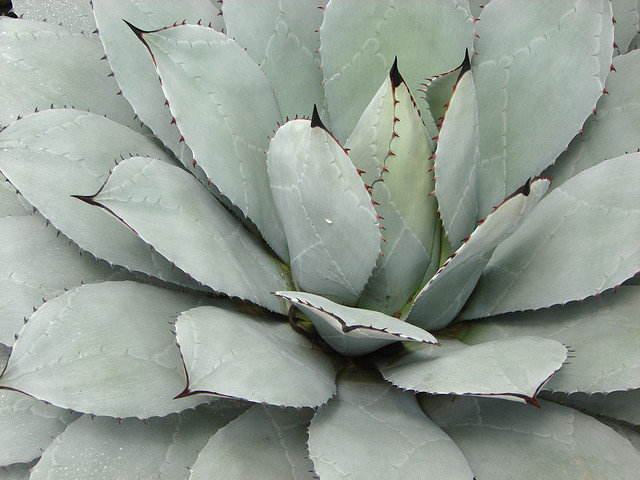
David de la Luz
Parry’s Agave(
Agave parryi)
Native to Arizona, New Mexico and northern Mexico
Parry’s agave’s glaucous gray leaves and dark spiny tips add drama and elegance to the desert garden. This agave can be used as an architectural centerpiece, reaching 2 to 3 feet in size, without dominating the landscape; it can also be massed. Parry’s agave is cold hardy for an agave — it grows in zones 4 to 11 — and can be grown in the ground or in a container.
Grow Parry’s agave in full sun to partial shade. It can survive on little to no water once established (avoid overwatering) and grows well in gravelly and rocky soils.
See more on how to grow Parry’s agave
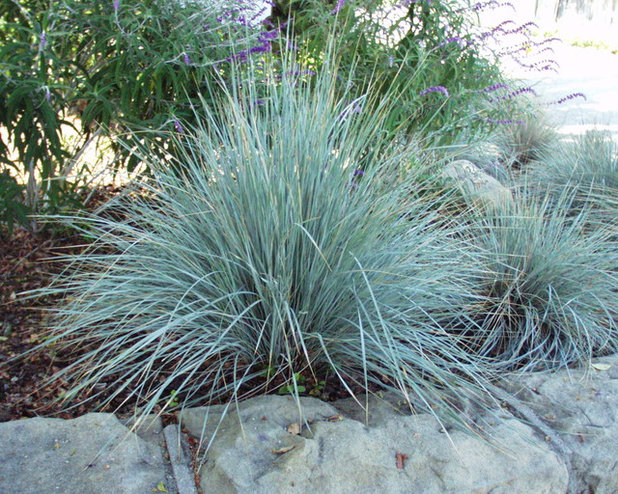
San Marcos Growers
Blue Oat Grass(
Helictotrichon sempervirens)
Native to central and southwestern Europe
This plant draws comparisons to blue fescue but is a little larger at 2 feet tall and wide, and appears softer, producing the windblown effect we expect from a grass. Flowers project a foot above the grass in summer and transition to a lovely gold in fall. Mass it or plant it on its own.
Blue oat grass comes in blues and greens and looks best when planted in full sun, though it can be grown in light shade. Hardy down to 0 degrees Fahrenheit, blue oat grass is evergreen in most climates and semievergreen in more extreme climates. It prefers occasional water but is drought tolerant.
See more on how to grow blue oat grass
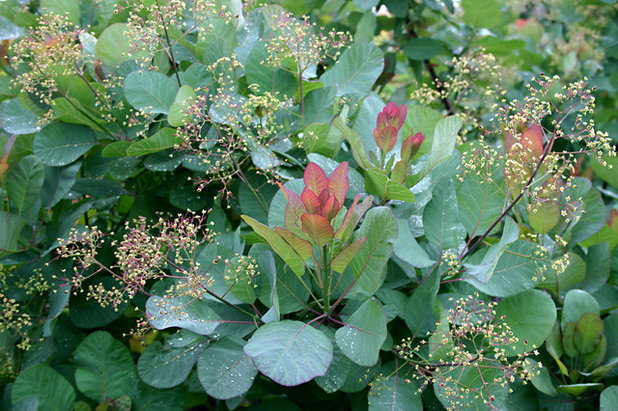
Henny Kolster
Old Fashioned Smoke Bush(
Cotinus coggygria ‘Old Fashioned’)
Foliage can be a great backdrop, but sometimes it can be a feature. The foliage of Old Fashioned smoke bush goes through quite the seasonal transformation — new growth starts out purple, then it transitions to a cool blue-green with red stems, then a bold pink in fall. In spring, while the leaves are green, bursts of light flowers explode all over the shrub. This shrub can grow up to 6 feet tall and 5 feet wide.
Plant it in full sun to partial shade in zones 5 to 10. All smoke bushes like fertile, well-drained yet moisture-retentive soil. It has average water needs. Check before you plant it, as it can be considered invasive in some areas.
See more on how to grow Old Fashioned smoke bush
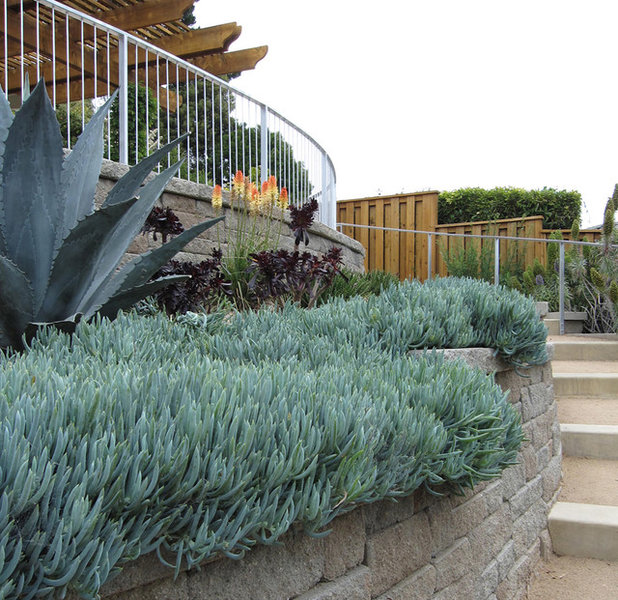
Shades Of Green Landscape Architecture
Blue Chalk Sticks(
Senecio mandraliscae)
Native to South Africa
For a contemporary, low-maintenance plant that can cover a lot of ground, look no further than blue chalk sticks. Bluish-gray fleshy spikes cascade over walls, along garden edges or in containers. This succulent fills in the landscape, spreading 2 to 3 feet wide and reaching 1 foot to 2 feet tall.
Grow it in full sun or light shade in dry climates. It can tolerate some water but is very drought tolerant and is considered a fire-wise plant. Blue chalk sticks grows well in coastal gardens, as it’s tolerant of salt spray and high winds. This plant prefers mild climates and is hardy to about 15 or 20 degrees.
See more on how to grow blue chalk sticks
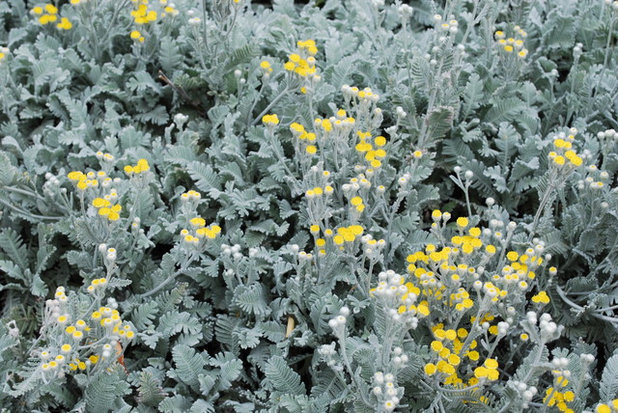
Jocelyn H. Chilvers
Partridge Feather(
Tanacetum densum sp
amani)
Native to southeastern Turkey
Soft evergreen foliage conceals partridge feather’s tough disposition. Yellow flowers attract butterflies in early summer while its velvet gray foliage persists. This low-growing shrub, at 6 to 8 inches tall, can be used as a trailing ground cover or bed edge.
Partridge feather can be grown at higher elevations and thrives with little water in a dry climate. It’s also pretty cold hardy, growing in zones 4 to 9. Grow it in full sun.
See more on how to grow partridge feather
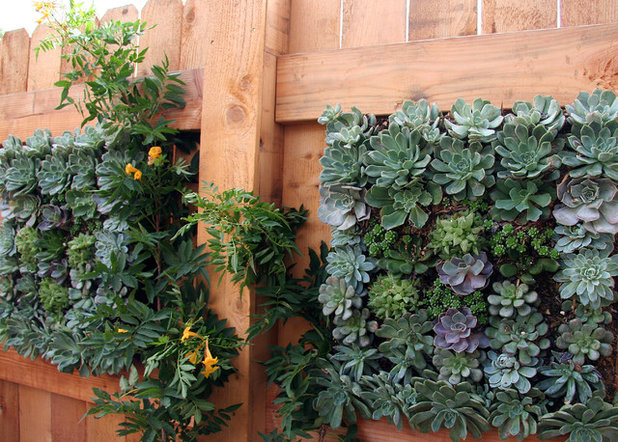
Donna Lynn - Landscape Designer
Echeveria(
Echeveria spp)
Native to semidesert regions of Mexico, Central America and South America
Compact Echeveria easily handles the heat as it cools down a garden. This succulent is evergreen and produces summer flowers on long inflorescences. Echeveria ranges in shades of blue to gray and even dusty purple. Top picks include ‘Fire and Ice’, ‘Imbricata’ and
Echeveria elegans. They are deer resistant.
This plant is very drought tolerant but looks best with some supplemental water. It grows well in full sun but should be sheltered from extreme heat. Once you buy one Echeveria, you’ll have a steady supply, since it can be propagated by cuttings or offsets. It’s cold sensitive, surviving temperatures down to 32 degrees, so you may want to plant it in a container to take inside. In more moderate climates, Echeveria can be planted directly in well-drained, sandy soil.
See more on how to grow echeveria
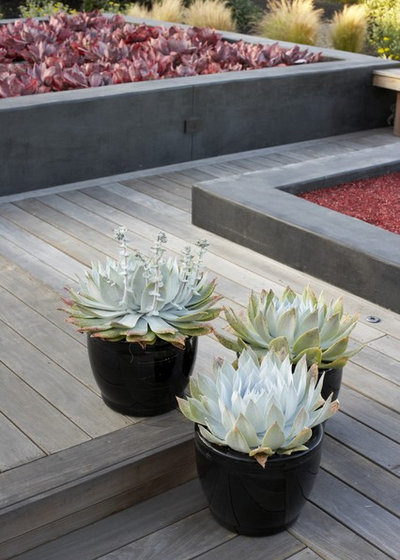
Jeffrey Gordon Smith Landscape Architecture
Dudleya(
Dudleya spp)
Native to California, Arizona, coastal Oregon and Baja California
The almost ghostly white shade of dudleya brightens the landscape in the rocky valleys and cliffs of the American Southwest. Dudleya is a resourceful grower and thrives with only minor supervision. Like other succulents, it will produce a flowering inflorescence but cannot be propagated by offsets.
It’s not particularly cold tolerant, surviving to 15 or 20 degrees. Dudleya prefers the typically wet winters and cool, dry summers of California. It grows best in full sun but is a winter grower, so is likely to look its best when many plants look their worst. Grow it along the coast or in the desert, and provide sandy, well-drained soil.
See more on how to grow dudleya
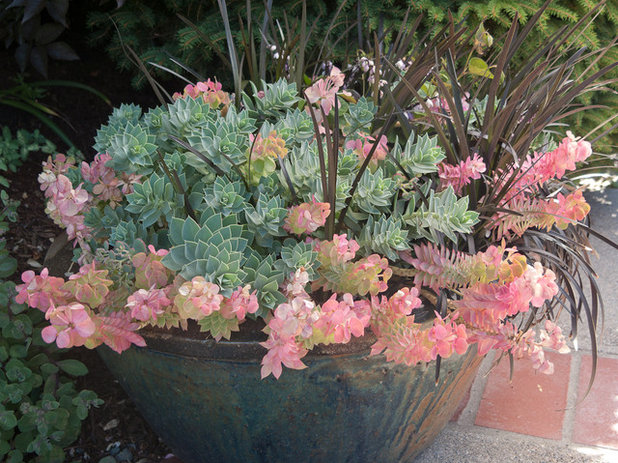
Le jardinet
Donkey Spurge(
Euphorbia myrsinites)
Native to Southern Europe and Asia Minor
Gray and chartreuse is a trendy color combination, and donkey spurge has both. Lime-green new growth projects from the ends of blue-gray stems. Its spiny leaves can be left to crawl along the ground or grow out from a container. This succulent is bold enough to be a focal point, but its soft gray color can recede, allowing its texture and other plants to stand out.
Donkey spurge is relatively cold hardy, growing down to zone 5. It’s a tough plant and can be transplanted year-round. It’s drought tolerant, prefers full sun to partial shade and grows to 14 inches tall and 12 inches wide.
See more on how to grow donkey spurge
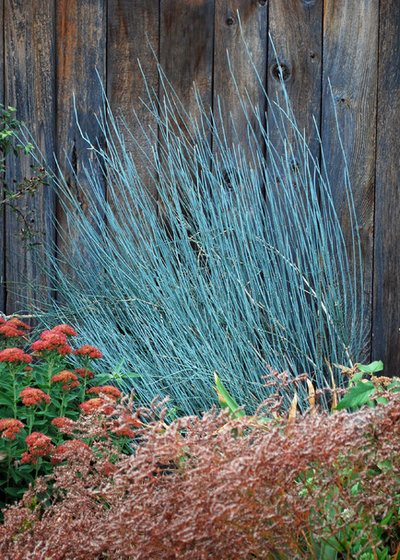
Jocelyn H. Chilvers
Bluestem Joint Fir(
Ephedra equisetina)
Native to central China
This bright blue shrub resembles a grass, but its erect stems stand tall year-round with no need to cut them back. Bluestem joint fir is a large garden addition, growing 4 to 6 feet tall and 3 to 8 feet wide, and it’s also pretty dense. Its chalk-blue color provides year-round interest; red berry-like fruit appears on female plants in summer.
Bluestem joint fir grows well in full sun, in alkaline soils with little water. It can grow in zones 4b to 9. Since it’s native to rocky regions, be sure the soil is well draining with no standing water.
See more on how to grow bluestem joint fir
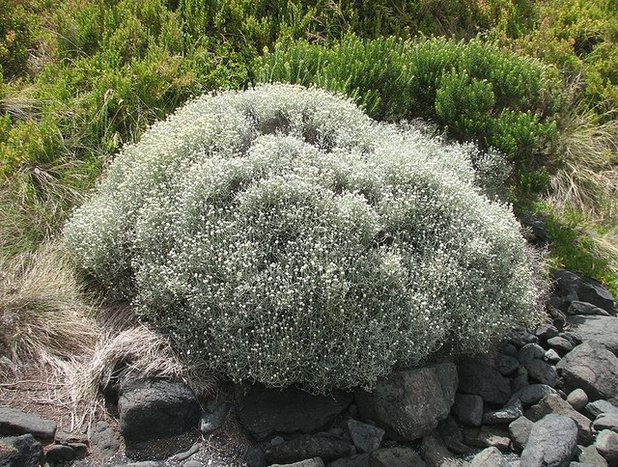 Cushion Bush
Cushion Bush(
Calocephalus brownii, syn
Leucophyta brownii)
Native to Australia
The soft foliage of this nearly white shrub may look more like something you’d see growing underwater than next to it. It grows up to 3 feet tall and wide and produces small white flowers in late spring or early summer. In winter the white coloring of the foliage becomes even more pronounced, transforming to an almost electric white. It adds interest to the winter garden, where it can glow in the darker days.
Native to the Australian coast, cushion bush prefers full sun and grows best in direct salt exposure. It prefers well-drained soil and does not like to be overwatered or in intense humidity. It’s not very cold hardy and is typically grown in zones 9 to 10.
See more on how to grow cushion bush
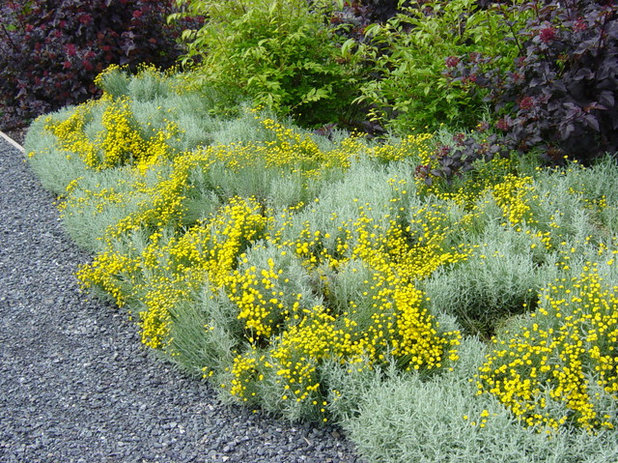
WBLA_Corky
Lavender Cotton(
Santolina chamaecyparissus)
Native to the western and central Mediterranean
Some plants shrivel and scorch in intense sun, but lavender cotton thrives in it. Upright bleached gray foliage is topped with sunny yellow flowers in mid to late summer. The foliage produces a wonderful aroma when bruised. Lavender cotton grows to 2 feet tall and 3 feet wide, in zones 6 to 9.
Provide lavender cotton with regular water to establish its root system, but it needs only occasional water once established. It is heat and drought tolerant, and tolerates wind and coastal conditions. It’s a very adaptable plant that grows best in sandy, well-drained soil. It’s also deer tolerant and considered a fire-wise plant.
See more on how to grow lavender cotton
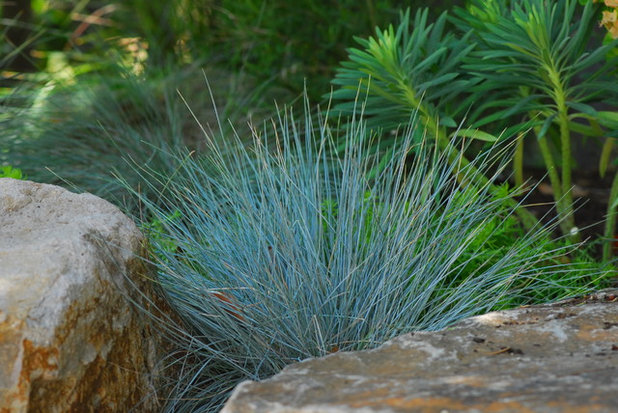
Astrid Gaiser Garden Design, LLC
Blue Fescue(
Festuca glauca)
Native to Central and Southern Europe
Planted between rocks, massed or in containers, blue fescue looks best in full sun. It can be short lived but can be divided and is easy to propagate. It grows to about 10 inches wide, and its golden flowers top out at 14 inches. Popular cultivars include ‘Elijah Blue’, ‘Blausilber’ and ‘Siskiyou Blue’.
Blue fescue likes full sun and is drought tolerant, though it looks best with supplemental water, especially in hotter climates. It tolerates coastal conditions and grows in zones 4 to 8.
See more on how to grow blue fescue
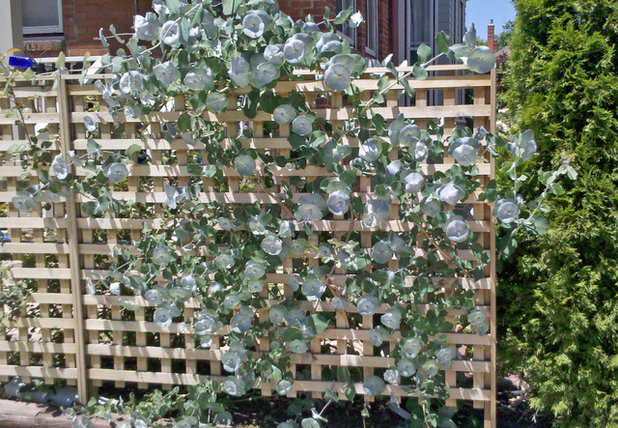
Jocelyn H. Chilvers
Kintzley’s Ghost Honeysuckle(
Lonicera reticulata ‘Kintzley’s Ghost’)
Kintzley’s Ghost honeysuckle cools the landscape with its muted colors. It’s a twining vine, so it can also shade the garden on pergolas or trellises. This deciduous vine produces yellow flowers in late spring that attract butterflies; red berries arrive in late summer. Specialized blue leaves, called bracts, that resemble round eucalyptus leaves persist through much of the year. It can grow up to 8 to 12 feet tall and spreads to 3 to 6 feet wide.
Plant it in full sun, but it can also tolerate partial shade. Kintzley’s Ghost can be grown in most soils and requires moderate watering. It is cold hardy and grows in zones 4 to 8.
See more on how to grow Kintzley’s Ghost honeysuckle
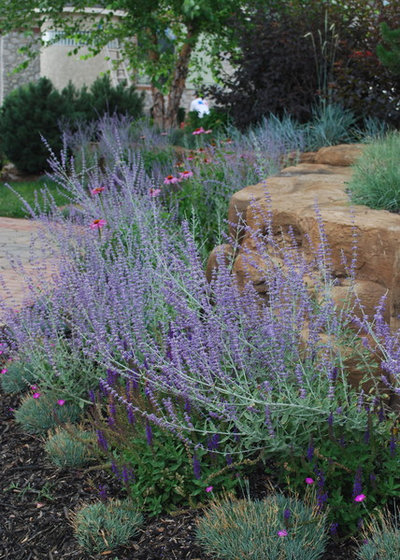
Jay Sifford Garden Design
Russian Sage(
Perovskia atriplicifolia)
Native to the Himalayas and western China
Russian sage may be most known for its flowers, but its form and foliage also deserve attention. Soft, grayish-green leaves emit a subtle sage aroma when brushed or bruised. Though its flowers fade, seed heads and a distinct skeletal structure produce unique winter interest. Russian sage reaches heights of 3 to 4 feet tall and wide, and its narrow stature means it fits well in tight spaces.
This plant grows best in full sun, preferring several hours a day. It has the potential to overpower surrounding plants, so be sure it’s not considered invasive in your area. Russian sage is used in xeriscape gardens but can handle some light watering — limiting watering might even prevent it from spreading. Plant it in dry, well-drained soil.
See more on how to grow Russian sage





